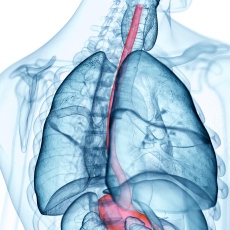Leading the way in Hartford
Connecticut Gastroenterology Associates, P.C.Esophogeal Disease The esophagus is the hollow tube that leads from the throat (pharynx) to the stomach. The walls of the esophagus propel food to the stomach not by gravity, but by rhythmic waves of muscular contractions called peristalsis. 
With age, the strength of esophageal contractions and the tension in the sphincters decrease. This condition, called presbyesophagus, makes older people more prone to backflow of acid from the stomach (gastroesophageal reflux), especially when lying down after eating. Two of the most common symptoms of esophageal disorders are dysphagia (an awareness of difficulty in swallowing) and chest or back pain. Dysphagia and chest or back pain may occur in any esophageal disorder, the most serious of which is esophageal cancer. External resourcesRead more | Leading the way in Hartford
Connecticut Gastroenterology Associates, P.C.Esophogeal Disease The esophagus is the hollow tube that leads from the throat (pharynx) to the stomach. The walls of the esophagus propel food to the stomach not by gravity, but by rhythmic waves of muscular contractions called peristalsis. 
With age, the strength of esophageal contractions and the tension in the sphincters decrease. This condition, called presbyesophagus, makes older people more prone to backflow of acid from the stomach (gastroesophageal reflux), especially when lying down after eating. Two of the most common symptoms of esophageal disorders are dysphagia (an awareness of difficulty in swallowing) and chest or back pain. Dysphagia and chest or back pain may occur in any esophageal disorder, the most serious of which is esophageal cancer. External resourcesRead more | Leading the way in Hartford
Connecticut Gastroenterology Associates, P.C.Esophogeal Disease The esophagus is the hollow tube that leads from the throat (pharynx) to the stomach. The walls of the esophagus propel food to the stomach not by gravity, but by rhythmic waves of muscular contractions called peristalsis. 
With age, the strength of esophageal contractions and the tension in the sphincters decrease. This condition, called presbyesophagus, makes older people more prone to backflow of acid from the stomach (gastroesophageal reflux), especially when lying down after eating. Two of the most common symptoms of esophageal disorders are dysphagia (an awareness of difficulty in swallowing) and chest or back pain. Dysphagia and chest or back pain may occur in any esophageal disorder, the most serious of which is esophageal cancer. External resourcesRead more |
|
|





